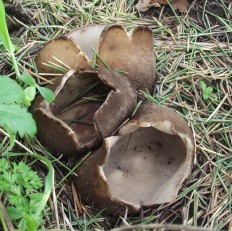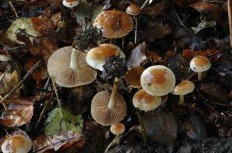Geopora Sumner where it grows, edibility, what it looks like, how to distinguish it, photo
Geopora Sumner: is it possible, description and photo
The representative of the Ascomycete department of the Sumner geopor is known under several Latin names: Sepultaria sumneriana, Lachnea sumneriana, Peziza sumneriana, Sarcosphaera sumneriana. It grows from the southern regions to the European part of the Russian Federation, the main accumulation in Siberia. An exotic-looking earthen mushroom is not used for gastronomic purposes.
How Sumner Geopora looks like
The Sumner geopore forms a fruiting body, which does not have a leg. The first stage of development takes place under the turf. Young specimens of the shape of a ball, as they grow, appear on the surface of the soil in the form of a dome. By the time of development, they completely leave the ground and plow up.

The external characteristics are as follows:
- fruit body in diameter - 5-7 cm, height - up to five centimeters;
- shape in the form of a bowl with serrated curved rounded edges, does not open up to a prone state;
- the walls are thick, brittle;
- the surface of the outer part is brown or dark beige with a densely spaced, long and narrow pile, especially pronounced in young representatives;
- the inner part is glossy with a smooth spore-bearing layer, cream or white with a gray tint;
- the pulp is light, dense, dry, brittle;
- the spores are very large, white.
Where does Sumner Geopora grow
The species is referred to as spring mushrooms, the first formation of fruiting bodies occurs in mid-March, if the spring is cold, then this is the first half of April.
It is found in the European part and the southern regions of the Russian Federation. On the Crimean coast, single specimens can be seen in mid-February. It forms a union only with a cedar. Grows in small groups in conifers or city alleys where this coniferous wood is found.
Among the Ascomycetes, the Sumner Geopore is the largest representative. It differs from a pine geopore in size.
There is a similar representative in symbiosis only with pine. Distributed in the southern climatic zone, found mostly on the Crimean coast. Fruiting in winter, a mushroom appears on the surface in January or February. The small fruiting body is dark brown with less pronounced ragged teeth along the edge. The main part is in the middle of a black or brown shade. Refers to inedible mushrooms. Therefore, there is no need to distinguish between representatives.
Is it possible to have a Geopore Sumner
No toxicity information available. Fruit bodies are very small, the pulp is fragile, in adult specimens it is rather tough, does not represent nutritional value. A mushroom with a complete lack of taste, it is dominated by the aroma of rotten coniferous litter or the soil on which it grows, belongs to the group of inedible species.
Conclusion
Geopora Sumner grows exclusively under the cedars, it has an exotic look of its own. Does not represent gastronomic value, belongs to the category of inedible mushrooms, is not used for food processing. Fruiting early in spring, arises in small groups.
Stropharia blacksporous (Stropharia melanosperma)
or
External description
Hat:
In young mushrooms, the cap is cushion-shaped. With age, the cap opens and becomes almost completely open. The diameter of the cap is 2-8 cm. The surface of the cap has all shades of yellow, from light yellow to lemon. Colored unevenly, whitish at the edges. Mature mushrooms have a faded cap. Sometimes, flaky remnants of the bedspread are visible along the edges of the cap. In wet weather, the cap is oily and smooth.
Pulp:
thick, rather soft, light. At the break, the flesh does not change color. Has an unusual sweetish odor.
Plates:
of medium width and frequency, adherent to the edges of the cap and stem. If you carefully cut off the leg, then the bottom surface of the cap becomes completely flat.In young mushrooms, the plates have a grayish color, then they become dark gray from ripe spores.
Spore Powder:
violet brown or dark purple.
Leg:
Stropharia blacksporous has a white leg. Up to ten centimeters long, up to 1 cm thick. The lower part of the leg is covered with small whitish-gray flakes. It may slightly thicken at the base. There is a small, neat ring on the leg. The ring, located high in the upper part, is at first white, later darkens from maturing spores. The surface of the leg may turn yellow with small spots. Inside, the leg is at first solid, then becomes hollow.
Spreading
According to some sources, Stropharia chernosporovaya bears fruit from the beginning of summer until an unknown time. Mushroom not very common... Grows in gardens, fields, meadows and pastures, sometimes found in forests. Prefers manured and sandy soils. Grows singly or in small groups. There are two or three mushrooms in an aggregate.
Similarity
Black-spore stropharia resembles a coppice or fine champignon. But, quite a bit, since the shape and color of the Stropharia plates, as well as the color of the spore powder, allow you to very quickly discard the version with Champignons. The same can be said about the white subspecies of Early Polevik.
Edibility
Some sources claim that Black Spore Stropharia is a mushroom edible or conditionally edible... One thing is certain, it is definitely not poisonous or hallucinogenic. True, it is not at all clear why this mushroom should be grown then.
Remarks
This porcini mushroom strongly resembles champignons, but when the plate is boiled, Stropharia lose their pigment, which is also its feature and difference.
Geopora pine: description and photo
| Name: | Pine Geopore |
| Latin name: | Geopora arenicola |
| Type of: | Inedible |
| Synonyms: | Sepultaria pine, Sepultaria arenicola, Lachnea arenicola, Peziza arenicola, Sarcoscypha arenicola, Lachnea arenicola |
| Systematics: |
|
Pine Geopora is an unusual rare mushroom of the Pyronem family, belonging to the Ascomycetes department. It is not easy to find in the forest, since within several months it develops underground, like its other relatives. In some sources, this species can be found as pine sepultaria, Peziza arenicola, Lachnea arenicola or Sarcoscypha arenicola. This species is called Geopora arenicola in the official reference books of mycologists.
What does pine geopora look like?
The fruiting body of this mushroom has a non-standard shape, since it does not have a leg. Young specimens have a spherical shape, which initially forms underground. And when it grows, the mushroom comes out to the surface of the soil in the form of a dome. During the ripening period, the pine geopore cap breaks and becomes like a star with ragged edges. But at the same time, the shape of the mushroom remains voluminous, and does not open to spread out.
The diameter of the upper part is 1-3 cm and only with rare exceptions can reach 5 cm. The walls are thick, however, with little physical impact, they easily crumble.
The inner side of the fruiting body has a smooth surface. The shade ranges from light cream to yellowish gray. Due to the nature of the structure, water is often collected inside.
The outer side is densely covered with a long, narrow pile. Therefore, when the fungus emerges on the soil surface, grains of sand get stuck in it. Outside, the fruit body is much darker and can be brown or ocher. On the break, a light, dense pulp is visible, which does not have a pronounced odor. When interacting with air, the shade is preserved.
The spore-bearing layer is located on the inner surface of a pine geopore. Bags are cylindrical 8-spore. The spores are elliptical with 1-2 drops of oil. Their size is 23-35 * 14-18 microns, which distinguishes this species from the sandy geopore.
The outer surface is covered with brown hairs with bridges
Where pine geopora grows
This species is classified as rare. It grows especially in the southern climatic zone.Pine geopora can be found in European countries, and successful finds have been recorded in the Crimea. The fruiting period begins in January and lasts until the end of February.
Grows in pine plantations. Prefers to settle on sandy soils, in moss and crevices. Forms a symbiosis with pine. Grows in small groups of 2-3 specimens, but also occurs singly.
Pine geopore develops in conditions of high humidity. Therefore, in dry periods, the growth of mycelium stops until favorable conditions resume.
Is it possible to eat pine geopora
This species is considered inedible. It can not be consumed fresh or after processing. However, no official studies on the toxicity of geopores have been carried out due to the small number.
The small size of the fruit body and the fragile pulp, which becomes tough when ripe, do not represent any nutritional value. In addition, the appearance of the mushroom and the degree of distribution are unlikely to cause a desire among fans of a quiet hunt to collect and harvest it.
Conclusion
Pine geopora is one of the representatives of the Pyronem family, characterized by an unusual structure of the fruit body. This mushroom is of interest to mycologists, since its properties are still poorly understood. Therefore, when you meet in the forest, you should not pluck it, it is enough to admire from a distance. And then this unusual mushroom will be able to spread its ripe spores.



































